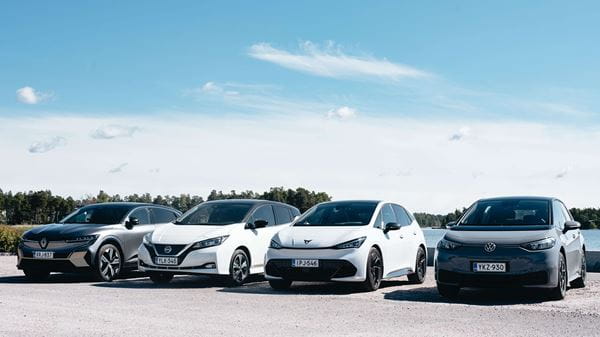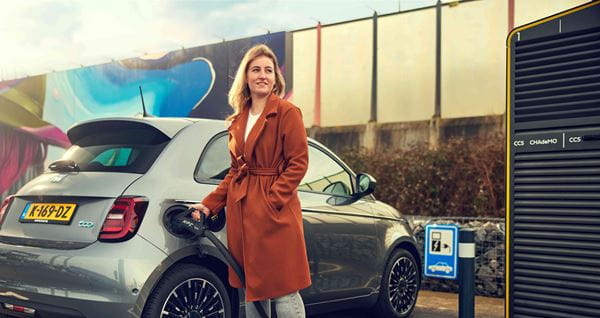
EV charging: How long does it take?
When it comes talking about electric vehicles it doesn’t take long before the conversation leads to charging. Questions like, what are the options and how long does it actually take are the most common ones we hear.
This blog will take you through:
- Variables affecting charging time
- Different types of chargers and their relative speeds
- Additional best practices
Variables affecting charging time
Maximum power of the charging station
Your EV charging time depends on:
- 1.the power of the charger,
- 2.the connection of your car and
- 3.the power provided to the charging station.
The actual charging speed is determined by the lowest of the 3 speeds.
Batteries have different capacities (measured in kWh). Larger batteries take longer to charge at the same power level, but higher capacity doesn’t always mean longer range. The weight of the vehicle, as well as driving efficiency, also influences range.
Battery size relative to maximum charging power
This ratio is what determines your charging speed. Vehicles with large batteries are normally compatible with more powerful chargers, to compensate for their increased size.
.jpg?rev=e3db11449a8d422e857694218cb331bc&mw=960)
State of charge
State of charge (SoC) refers to the fullness of an EV battery. To stop your battery degrading over time, it’s best to stop the SoC from going too low or too high. Experts recommend keeping your EV between 10% and 90% charge if possible. If you’re out of the house and not taking your car, you should keep the car plugged in but set the charge to 90%. This will stop the battery from overcharging.
Driving behaviour
Most new EVs use advanced e ‘active cooling’ – this feature makes fast charging possible even after driving at high speeds. EV drivers should watch their speed, as overusing the accelerator can damage battery health in the short and long term.
External temperature
An EV battery performs best between 20 and 30 degrees Celsius. In cold weather, the battery has to warm up before it can charge properly. High-end brands, such as Tesla, have pre-heating enabled for fast charging. This costs energy but gets you back on the road quicker. If your EV doesn’t have pre-heating, be prepared to wait longer for a charging in the winter months.
Types of chargers
Chargers come in two main categories: alternating current (AC) and direct current (DC). AC chargers are typically installed in home and near-home environments. The standard is AC Type 2 and is quite powerful – All EVs can be charged overnight with this type. Type 2 chargers have a maximum power rate of 22kW when used at home. Renault also has its own AC charger: Mennekes AC, which has a maximum power of 43kW.
DC chargers are considerably faster. Usually found at public charging stations, they can take a battery up to 80% charge in just 20 minutes. There are three common types of DC charger:
CCS: the most widespread DC charger, with a maximum power of 350kW DC.
Compatible with vehicles from Hyundai, BMW, Volvo, Audi, Jaguar, Volkswagen, Lucid, Mercedes, Chevrolet, Porsche, Smart, Honda, Rimac and Tesla 3. CCS can also be used for AC charging.
Tesla Supercharger: used by all Tesla models, this charger has a maximum power of 1250kW DC. Tesla charging stations also include CCS plugs; these can only be used with an adapter.
Additional best practices
Plan your route to optimise battery usage
There are several apps to help you plan the perfect route. We recommend using Shell Recharge, which gives users access to around 300,000 charging points across Europe. The app has a route planning feature that shows you available charging stations and lets you filter for different charging speeds.
Don’t overuse fast charging
Fast charging is a quick fix, not a long-term solution. Using a fast charger puts a lot of current into the batteries in a short period of time, and the increased strain means the battery wears down faster. According to Kia, eight years of standard charging will give you 10% more battery life than eight years of fast charging.
Still got questions? Check out our FAQs for EV charging!
Our net-zero commitment
LeasePlan is leading the transition to zero-emission mobility and has set itself the goal to achieve net-zero tailpipe emissions from its funded fleet by 2030. As a founding member of the EV100 – a global initiative of forward-looking companies committed to accelerating the transition to EVs – sustainable mobility is at the heart of everything we do.




